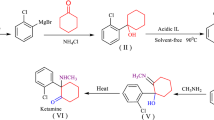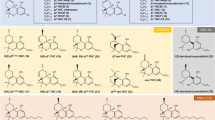Summary
Metabolites of (14C)tetrahydronorharmane (THN, tetrahydro-β-carboline) have been identified by mass spectrometry and nuclear magnetic resonance spectroscopy. Two metabolic pathways are suggested:
-
1.
Hydroxylation of the benzene ring — most probably with an epoxide as intermediate — though no hydroxylated THN could be detected in the urine samples of male and female rats but conjugated compounds as the main metabolites. The intermediary epoxide is supported by the fact, that the hydroxy substituent of THN is positioned on C-6 or C-7 with a ratio of 55:45 in female rats and of 45:55 in male rats.
-
2.
Dehydrogenation yielding norharmane. This substance possibly gives rise to another metabolite — 1,2-dihydro-β-carboline-1-one.
The pharmacological and toxicological implications of these findings are discussed.
Similar content being viewed by others
References
Barker SA, Harrison RE, Monti JA, Brown GB, Christian ST (1981) Identification and quantification of 1,2,3,4-tetrahydro-β-carboline, 2-methyl-1,2,3,4-tetrahydro-β-carboline, and 6-methoxy-1,2,3,4-tetrahydro-β-carboline as in vivo constituents of rat brain and adrenal gland. Biochem Pharmacol 30:9–17
Braestrup C, Nielsen M, Olsen CE (1980) Urinary and brain β-carboline-3-carboxylates as potent inhibitors of brain benzodiazepine receptors. Proc Natl Acad Sci USA 77:2288–2292
Coutts RT, Locock RA, Slywka GWA (1970) Mass spectra of selected beta-carbolines (β-9H-pyrido-(3,4-b)) indoles. Org Mass Spectr 3:879–889
Dajani RM, Saheb SE (1973) A further insight into the metabolism of certain β-carbolines. Ann NY Acad Sci 215:120–123
Desmarchelier JM, Johns RB (1969) Mass spectra of indazolones and pyrazolones 1: indazolones. Org Mass Spectr 2:37–47
Fischer Th (1975) Untersuchungen zur “Carbolin-Blau” Reaktion. Inaug. Diss. Freie Universität Berlin
Fujino T, Fujiki H, Nagao M, Yahagi T, Seino Y, Sugimura T (1978) The effect of norharmane on the metabolism of benzo(a)pyrene by rat liver microsomes in vitro in relation to its enhancement of the mutagenicity of benzo(a)pyrene. Mutat Res 58:151–158
Greiner B (1983) Untersuchungen zur Pharmakokinetik and Identifizierung von Metaboliten des Tetrahydronorharmans bei der Ratte. Inaug. Diss. Freie Universität Berlin
Greiner B, Fähndrich Ch, Strauss S, Rommelspacher H (1983) Pharmacokinetics of tetrahydronorharmane (tetrahydro-β-carboline) in rats. Naunyn-Schmiedeberg's Arch Pharmacol 322:140–146
Honecker H, Rommelspacher H (1978) Tetrahydronorharmane (tetrahydro-β-carboline) a physiologically occuring compound of indole metabolism. Naunyn-Schmiedeberg's Arch Pharmacol 305:135–141
Jernström B, Vadi H, Orrenius S (1977) The role of liver nucleic in the formation of DNA binding products from benzo(a)pyrene. In: Ullrich V, Roots I, Hildebrandt A, Estabrook RW, Conney AH (eds) Microsomes and drug oxidations. Pergamon Press, Oxford New York Toronto Sidney Paris Frankfurt, pp 395–402
Oesch F (1976) Metabolic transformation of clinically used drugs to epoxides: New perspectives in drug-drug interactions. Biochem Pharmacol 25:1935–1937
Rommelspacher H, Honecker H, Barbey M, Meinke B (1979) 6-Hydroxytetrahydronorharmane (6-hydroxytetrahydro-β-carboline), a new active metabolite of indolealkylamines in man and rat. Naunyn-Schmiedeberg's Arch Pharmacol 310:35–42
Rommelspacher H, Nanz C, Borbe HO, Fehske KH, Müller WE, Wollert U (1980) 1-Methyl-β-carboline (harmane) a potent endogenous inhibitor of benzodiazepine receptor binding. Naunyn-Schmiedeberg's Arch Pharmacol 314:97–100
Rommelspacher H, Nanz C, Borbe HO, Fehske KH, Müller WE, Wollert U (1981) Benzodiazepine antagonism by harmane and other β-carbolines in vitro and in vivo. Eur J Pharmacol 70:409–416
Rommelspacher H, Brüning G, Schulze G, Hill R (1982) The in vivo occurring β-carbolines induce a conflict-augmenting effect which is antagonized by diazepam: correlation to receptor binding studies. In: Hucho F (ed) Neuroreceptors. De Gruyter, Berlin New York, pp 27–41
Rommelspacher H, Brüning G (1984) Formation and function of tetrahydro-β-carbolines with special reference to their action on (3H)tryptamine binding sites. In: Schloßberger HG, Kochen H, Linzen A, Steinhart R (eds) Tryptophan. De Gryter, Berlin New York, pp 209–216
Shannon JS (1962) Studies in mass spectrometry. I. Structures and reactions of ions from benzylalcohol, ortho-, meta- and parahydroxybenzylalcohols, and their o-deuterated derivatives. Aust J Chem 15:265–277
Skup M, Oderfeld-Nowak B, Rommelspacher H (1983) In vitro studies on the effect of β-carbolines on the activities of acetylcholinesterase and on the muscarinic receptor binding of the rat brain. J Neurochem 41:62–68
Spiteller M, Spiteller G (1973) Massenspektrensammlung von Lösungsmitteln, Verunreinigungen, Säulenbelegmaterialien und einfachen aliphatischen Verbindungen. Springer, Wien New York
Sternbach LH, Koechlin BA, Reeder E (1962) Quinazolines and 1,4-benzodiazepines. VIII. The photoisomerization of 7-chloro-2-methylamino-5-phenyl-3H-1,4-benzodiazepine 4-oxide. J Org Chem 27:4671–4672
Vaz AD, Fiorica VM, Griffin MJ (1981) New heterocyclic stimulators of hepatic epoxide hydrolase. Biochem Pharmacol 30:651–656
Vejdelek ZJ, Treka V, Protiva M (1961) Synthetic experiments in the group of hypotensive alkaloids. XXI. Chemistry of 1,2,3,4-tetrahydronorharmane-1-carboxylic acid and derivatives. J Med Pharm Chem 3:427–440
Author information
Authors and Affiliations
Rights and permissions
About this article
Cite this article
Greiner, B., Rommelspacher, H. Two metabolic pathways of tetrahydronorharmane (Tetrahydro-β-carboline) in rats. Naunyn-Schmiedeberg's Arch. Pharmacol. 325, 349–355 (1984). https://doi.org/10.1007/BF00504380
Received:
Accepted:
Issue Date:
DOI: https://doi.org/10.1007/BF00504380




